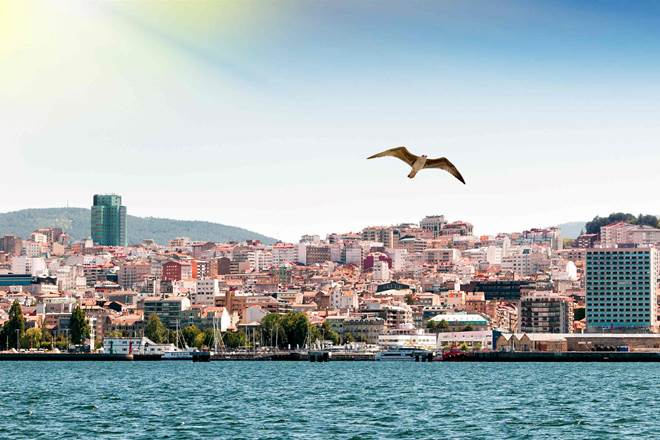The port of Vigo in the underrated Spanish region of Galicia is one of the finest natural ports in the world and its fishing origins have left an indelible mark on the city’s divine selection of seafood. Visitors are treated to ancient Roman ruins, neoclassical churches and an historic old town.
Vigo serves as the perfect launchpad to visit the picturesque towns and villages along the Vigo Estuary and the Cies Islands that form part of the National Park of the Atlantic Islands.
Read on to help us plan your visit to the Spanish city of Vigo in style.
Image Credit: Getty Images, Gonzalo Azumendi. Image Location: Rodas Beach, Cies Islands, Galicia, Spain
Where is Vigo, Spain?
Vigo is a seaside city in the northwest of Spain. It is in the region of Galicia and in the province of Pontevedra. It is around 25 miles north of the Portuguese border and faces onto the Ría de Vigo—one of four coastal inlets on the Atlantic Ocean that make up the Rías Baixas on the southwestern coast of Galicia. Trains from Madrid to Vigo take around 4 hours 30 mins.
What is the weather like in Vigo?
Galicia is generally milder and wetter than the rest of Spain, with its climate influenced heavily by its position on the Atlantic Ocean. Vigo has a climate roughly comparable to the Pacific Northwest in the US.
The temperature in Vigo is highest during the summer months of June, July, August and September, with temperature averages in the mid 70s Fahrenheit. In the coldest and wettest winter months of December, January and February, temperatures average in the mid 50s Fahrenheit with an average of 12 days of rain per month.
Image Credit: Getty Images, James Longworth. Image Location: Parque do Castro, Vigo, Galicia, Spain
The best things to do in Vigo, Spain
Take a boat to the Cies Islands
A 40-minute boat ride west of the city will bring you to the Cies Islands, an untouched archipelago complete with white sandy beaches and crystal-clear water. Enjoy one of the four hiking trails through pine-tree forests up to dramatic viewpoints, before settling down to lunch at the single restaurant on Rodas Beach. Daily visitor numbers are capped so you’ll never feel like the islands are overcrowded, while if you’re lucky you might see dolphins and whales in the water as well as the thousands of gulls, petrels, pelicans and raptors that call the islands home.
Be avant-garde at Museo de Arte Contemporánea de Vigo
Vigo is a great place for culture vultures, with a host of museums and galleries to explore. MARCO—the Museo de Arte Contemporánea de Vigo—was founded in 2002 and is housed in the city’s former prison; it displays a wide range of contemporary exhibits from both established artists and newcomers alike. The museum’s diverse collection includes paintings, sculptures, installations and multimedia works, with a focus on the avant-garde and cutting-edge works of the 20th and 21st centuries.
Explore Vigo's old town, Casco Vello
Vigo’s Casco Vello old quarter rises up from the busy port area with a series of pretty cobbled streets and sleepy squares. Lots of the buildings are made from Galician granite which give the area a stately if slightly crumbly feel. Cesteiros Street was the heart of the basket-weaving industry, for the storage of fish and other foods. Right in the center of the old town sits La Colegiata, the city's cathedral, which was built in 1811 on top of a former church and contains a number of stunning murals.
Enjoy the sunset in Parque do Castro
Directly south but uphill from the old town you’ll find the Parque do Castro, a magnificent place to explore particularly when the sun is setting. Check out the partly reconstructed Casto de Vigo which dates back to the 3rd century BCE and poke around the hilltop Castelo do Castro which formed part of Vigo’s defenses built in the 17th century.
Catch a game at Estadio Municipal de Balaídos
Soccer fans will be keen to visit the Estadio Municipal de Balaidos, home to Spanish La Liga club Celta Vigo. The stadium has a capacity of almost 25,000 and is a great place to catch a game. The stadium first opened in 1928.
Image Credit: Getty Images, David Andres Gurierrez. Image Location: Vigo, Galicia, Spain
Where are the best beaches in Vigo?
Given Vigo’s position on the coast you won’t be surprised to learn that there are 47 coves and beaches spread throughout the municipality, including sandy areas with waves for water sports as well as wild coves, family beaches, nudist beaches, and urban beaches.
Some of these coves and beaches are equipped with showers, footbaths, lifeguards and water sport activities, with 10 beaches in Vigo awarded the blue flag distinction from the Association for Environmental and Consumer Education (ADEAC) including the Playa de Samil—around 4 miles away from the city center—and the Praia do Vao.
How to get to Vigo by train
Now that Galicia has a high-speed rail link to Madrid, you can get to this underrated region faster than ever by train. Download the Trainline App and grab some hot deals, so you can enjoy the quiet beaches, sleepy towns and fantastic seafood on offer in Vigo. Find out more with our guides to train travel in Spain and how to book online train tickets in Spain.
Header Image Credit: Getty Images, Fernando Nieto Fotografía. Image Location: Vigo, Galicia, Spain


